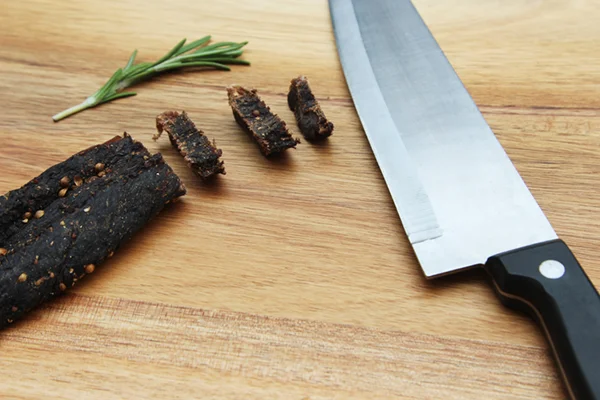Origins of Biltong: Early Preservation Methods
The history of Biltong can be traced back to the indigenous tribes of Southern Africa, who devised ingenious preservation methods to ensure their meat lasted during long journeys and harsh environmental conditions. One of the earliest methods involved salting and air-drying strips of meat, a technique that allowed the tribes to preserve their food without the need for refrigeration. This process not only helped them survive in challenging terrains but also led to the development of what we now know as Biltong.
Furthermore, these early preservation techniques were closely tied to the nomadic lifestyle of many African tribes, where the ability to store and carry food was crucial for survival. By combining salt, vinegar, and spices with strips of meat from wild game animals, they created a high-protein snack that could sustain them on their travels. As European settlers arrived in Southern Africa, they adopted and adapted these preservation methods, incorporating new flavors and techniques into the evolving tradition of Biltong production.
Overall, understanding the early preservation methods used by indigenous tribes provides valuable insight into how Biltong became an integral part of South African culture and cuisine. It also highlights the resourcefulness and ingenuity of these communities in maintaining a sustainable food supply through innovative preservation practices.

The history of Biltong
The Influence of South African Culture
The influence of South African culture on the history of biltong is undeniable, as this traditional dried and cured meat holds a special place in the hearts and palates of many South Africans.
The process of creating biltong dates back to the indigenous Khoikhoi and San people, who developed it as a means of preserving meat in the warm, dry climate of southern Africa.
This deeply-rooted cultural practice has endured over generations, evolving into a defining aspect of South African culinary heritage.
The flavors and techniques used in biltong preparation are reflective of South Africa’s multicultural society, with influences from Dutch settlers and indigenous traditions contributing to its unique taste profile. Moreover, biltong has become an integral part of social gatherings and sporting events across South Africa, symbolising unity and camaraderie among diverse communities. Its enduring popularity not only showcases the resilience of cultural practices but also serves as a testament to the rich tapestry that is South African culture.
Evolution of Biltong Ingredients and Recipes
The evolution of biltong ingredients and recipes offers a fascinating glimpse into the cultural diversity that has shaped this beloved South African snack. Traditionally, biltong was made from game meat such as springbok or kudu, seasoned with a simple mix of salt, vinegar, coriander, and sometimes pepper. However, as colonial influences spread across Southern Africa, new ingredients like garlic, sugar, and various spices were incorporated into biltong recipes to create diverse flavor profiles.
In modern times, the evolution of biltong has seen an expansion in ingredient choices with the inclusion of beef as the primary meat source. Additionally, innovative chefs have experimented with different marinades and seasonings to cater to evolving tastes while still respecting the traditional flavor profile. This ongoing adaptation reflects how food traditions can adapt without sacrificing authenticity—showcasing the dynamic nature of culinary heritage in today’s global society.
Biltong in Modern Times: Popularity and Varieties
As Biltong has evolved with the times, it has seen a surge in popularity in modern society. This South African dried meat snack has spread far beyond its origins and is now enjoyed by people all over the world. Its appeal lies in its high protein content, unique flavor, and convenient packaging, making it a favorite among health-conscious consumers and athletes looking for a nutritious on-the-go snack.
Furthermore, the varieties of Biltong available today have expanded to cater to diverse tastes and dietary preferences. From traditional beef Biltong to game meat options like ostrich and venison, there is now a wide selection of flavors and textures for enthusiasts to explore. Additionally, innovative seasoning combinations such as peri-peri or garlic have given Biltong a contemporary twist that appeals to adventurous food lovers seeking new taste sensations. With these developments, Biltong continues to thrive as a versatile and beloved snack option in modern times.

Biltong Kits and Jerky Kits have become a growing trend among individuals who are interested in making their own biltong at home. This South African dried and cured meat snack has gained popularity not only for its delicious flavor, but also for the satisfaction of creating it from scratch.
The kits typically contain all the necessary ingredients and spices needed to make biltong at home, providing a convenient way for people to try out this traditional food-making process. By purchasing a kit, enthusiasts can experiment with different flavors and methods of curing, allowing them to further customize their biltong according to personal preferences.
These kits also offer an educational aspect, allowing users to learn about the process of preserving meat and gain a deeper understanding of traditional food preparation techniques. As more people seek to embrace culinary traditions from around the world, biltong kits offer an engaging and hands-on experience that appeals to those looking for a new cooking challenge.
Furthermore, the convenience of having all the necessary tools in one package makes biltong kits an attractive option for those new to the art of preserving meats, as well as seasoned chefs looking to broaden their culinary skills. With the rising interest in artisanal and homemade products, biltong kits represent a fun and accessible way for individuals to delve into the world of food preservation while enjoying the savory rewards of their efforts.
Cultural Significance and Traditions Surrounding Biltong
The cultural significance of biltong is deeply rooted in South African heritage and traditions. Dating back to the 17th century, when Dutch settlers arrived in South Africa, biltong was initially created as a means of preserving meat for long journeys and harsh climates. This traditional method of curing meat soon became an integral part of indigenous South African cuisine, and today biltong holds a cherished place in the country’s culinary landscape.
Furthermore, the process of making biltong has become a time-honored tradition passed down through generations. It involves carefully selecting high-quality cuts of meat and marinating them with a unique blend of spices before hanging them to dry. Each family may have its own secret recipe, creating a sense of pride and cultural identity around their particular method of preparing this beloved snack. As such, biltong has transcended from being just a food item to symbolizing the rich historical tapestry that makes up South African culture.
Global Impact: Spread and Adaptations
The global impact of Biltong has been steadily growing, with the delicious South African snack now finding its way into markets around the world. Its adaptability and long shelf life have made it a popular choice for outdoor enthusiasts, hikers, and campers who need a convenient source of protein on their adventures. Additionally, its low carbohydrate content has also contributed to its popularity as a healthy snack option among fitness enthusiasts and health-conscious individuals.
One fascinating aspect of Biltong’s global spread is how different regions have adapted the traditional recipe to suit their own culinary preferences. In the United States, for example, some producers are experimenting with unique flavors like barbecue and chili lime to cater to local tastes. In Asia, manufacturers are incorporating traditional spices and seasonings from their respective cultures into Biltong production, offering a fusion of flavors that resonate with local consumers. This widespread adaptation not only speaks to Biltong’s versatility but also reflects the diverse palates of people across the globe.
Biltong’s Enduring Legacy
In conclusion, Biltong’s enduring legacy is a testament to the rich and flavorful history of South African cuisine. From its humble origins as a means of preserving meat in the hot and dry climate of southern Africa, to its current status as a beloved snack and culinary export, biltong has firmly established itself as an iconic part of South African culture. Its influence has spread far beyond the borders of its country of origin, gaining popularity in various parts of the world and captivating people with its unique taste and texture.
Furthermore, biltong’s enduring legacy also symbolizes resilience and adaptability. Despite centuries of changes in lifestyle, technology, and eating habits, biltong has remained relevant and cherished by both traditionalists seeking a taste of nostalgia and modern consumers looking for wholesome protein-packed snacks. Its ability to evolve with the times while still staying true to its roots guarantees that biltong will continue to be an integral part of global food culture for generations to come.
